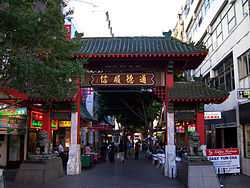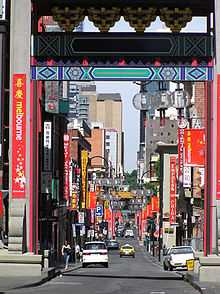Chinatowns in Australia
| Chinatown | |||||||
 Cover of sheet music, published in 1910 | |||||||
| Chinese | 唐人街 | ||||||
|---|---|---|---|---|---|---|---|
| |||||||
| Alternative Chinese name | |||||||
| Traditional Chinese | 中國城 | ||||||
| Simplified Chinese | 中国城 | ||||||
| |||||||
| Second alternative Chinese name | |||||||
| Traditional Chinese | 華埠 | ||||||
| Simplified Chinese | 华埠 | ||||||
| |||||||
| Chinatowns |
|---|
Chinatowns in Australia exist in most states and capital cities with historic former Chinatowns in frontier and rural areas.
Given the proximity to the Asian continent, Australia has had, and continues to witness, a massive immigration of Chinese and other Asians. The majority of ethnic Chinese immigrants to Australia are from Canton and Hong Kong. Chinese from various places of mainland China, Macau, Taiwan, Korea, Southeast Asia—especially Vietnam, Laos, Cambodia, Philippines, and Indonesia—and Latin America also settled Australia.
Many early Chinese from the Guangdong and Fujian provinces of China immigrated to Australian gold rushes. They were mainly Chinese of Taishan, Cantonese, Zhongshan, Hokkien, and Hakka origin. As in North America, the Chinese faced massive institutionalized discrimination, and Asian immigration was restricted by the White Australia Policy in the late 1880s. It was repealed by the 1970s under multiculturalist policies, which in turn ushered in a new wave of Asian immigration, particularly from Hong Kong and the People's Republic of China, and giving rise to several Australian Chinatown communities.
Australian Capital Territory

A contemporary Chinatown exists at Woolley Street in the Dickson Centre, Australian Capital Territory. The Chinatown has become established fairly recently as a restaurant precinct.
New South Wales
Sydney

Sydney's Chinatown is the third area to bear that name. Originally in The Rocks area of Sydney, it later moved to the area near Market Street at Darling Harbour and finally to its current location in Haymarket, around parallel streets Dixon Street and Sussex Street. This Chinatown hosts various Chinese cultural activities such as the Chinese Youth League of Australia [1] and Catholic Mass in Cantonese at the St. Peter Julian's Catholic Church.[2]
Other suburban Chinatowns have cropped up over the years in the suburbs of Burwood, Campsie, Ashfield, Auburn, Fairfield, Marrickville, Chatswood, Eastwood, Parramatta, and Hurstville.
Victoria
Ballarat
An extensive historical Chinatown existed in Golden Point, Victoria, a district of the city of the gold field city Ballarat[3] While the settlement no longer exists, it is remembered at nearby Sovereign Hill.
Bendigo
Several Chinatowns were established in Bendigo during the Victorian Gold Rush of the 1850s and 1860s. These were the Chinese camps, of which there were seven established.[4] The Ironbark camp in North Bendigo became the most prominent in the 1850s and 1860s. It continued to be the centre of Chinese life in Bendigo until it was ravaged by fire for a second time in 1911. A Joss House, one of Victoria's oldest, is the only thing remaining on the site. After the fire at the Ironbark camp, those Chinese still in Bendigo moved their operations to Bridge St, nearer the centre of Bendigo. This Chinatown survived until 1964 when the council cited its declining use and dilapidated state as reasons for its demolition. A car park was put in its place. In 1991 the Bridge St Chinatown became the site of the Golden Dragon Museum which includes many relics from the city's Chinese heritage.[5]
Castlemaine
A historic Chinatown existed in Castlemaine during the Victorian Gold Rush in the 1860s near the corner of Mostyn and Union Street (current site of the Albion Hotel) which included as many as five Joss Houses and a Chinese Mission Chapel.[6]
Creswick
A historical Chinatown existed in Creswick during the Victorian Gold Rush in the 1850s.[7] The settlement was depicted in Watercolor paintings artists by Burkitt (1855) and Norman Lindsay (1894).
Melbourne

Melbourne's Chinatown is in Little Bourke Street. It is notable as the oldest Chinatown in Australia,[8] the oldest continuous Chinese settlement in Australia, and the longest continuously running Chinatown outside of Asia. Suburban Chinese communities, of a mostly Cantonese culture, are in Doncaster, Box Hill, Springvale and Glen Waverley. Melbourne's Chinatown boasts some world famous cuisine, Flower Drum for example was voted as one of the best Chinese restaurants in the world by the New York Times. It was also the location where the Dim Sim, a popular Chinese-Australian snackfood commonly served in takeaway outlets throughout the country, was first invented by William Wing Young, at his restaurant Wing Lee, in 1945. Gift shops and souvenir shops also make up a large proportion of businesses. Melbourne Chinatown also houses the world's longest annually paraded Chinese dragon in the Melbourne Chinese Museum. This record is believed to have been held by the city since 1978 when the original Dai Loong dragon was commissioned, which was also the first Chinese dragon built in China since 1948. It was 92 metres long, had 6160 scales on its body and was initially paraded with a procession involving over 200 participants. In 2003, it was replaced with a new dragon, the Millennium Dragon, which was deliberately crafted in order to retain the record, and required 8 people to hold its head up. This later dragon is also locally known as Dai Loong, as some parts of the original 1978 dragon were reconditioned for use in the new dragon.[9]
Queensland

Brisbane
The Chinatown of Brisbane is located in the suburb of Fortitude Valley, complete with its own Chinese gateway. Located near the Story Bridge, Chinatown is very popular for Australians too.
Gold Coast
A Chinatown on the Gold Coast is proposed for Southport.[10] The proposed design includes three Peifang gates (arches) at each of the three entrances to Davenport and Young Streets.[11]
Chinatown Gold Coast The $6.8 million Chinatown precinct is an integral part of the revitalisation of Southport as an international CBD for the Gold Coast. Chinatown is being developed in partnership with the community, private sector and government. It will offer an authentic Asian experience and create a unique destination on the light rail corridor in the heart of the CBD.
Chinatown is already encouraging Chinese and Asian tourists and fostering international relationships and investment, reinforcing the City as a destination to do business, be entertained, to live and be educated.
Chinatown will provide a sense of home for the Chinese and Asian community that permanently reside on the Gold Coast. As part of the Mayor’s second home strategy, Gold Coast Chinatown will bring a sense of safety and community to the thousands of international students studying at Gold Coast universities, English language schools and colleges.
This modern Chinatown is focused on Young and Davenport Streets in Southport. It will be a place for the Gold Coast to celebrate its diversity through culture, design, people and food. Chinatown will be an exciting mix of restaurants, cultural festivals and boutique; a place of cultural indulgence and celebration.
A four metre high statue of Confucius was recently unveiled and soon, three paifangs - traditional Chinese gateways - will mark the entries to the precinct.
Gold Coast Chinatown will be true to the Gold Coast spirit and will represent our new world relationship with the Asia-Pacific region
South Australia
Adelaide
Adelaide's China Town is located in the Adelaide Central Markets precinct, on Moonta Street, between Grote and Gouger streets. Two impressive Paifang mark the entrances at either end. Adelaide China Town consists mainly of oriental restaurants, grocery stores and markets.
Northern Territory
Darwin
The first Chinatown in Darwin existed in the 1880s. A new synthetic Chinatown of Darwin, Northern Territory is in development and it is to be finished in 2010 at a cost of A$90 million.[12]
Western Australia
Perth
Perth has a Chinatown on Roe Street in the inner-city suburb of Northbridge. There are many more Asian businesses found on William St, Northbridge than at the official Chinatown. Historically many Chinese (usually of Malaysian, Singaporean or Indonesian background) settled in Northbridge alongside other immigrant groups. The city's low density population and comparatively cheap property encourages migrants to move to the expanding suburbs. Asian students often chose to live in suburbs near universities, such as Bentley, Murdoch and Nedlands.
References
- ↑ 澳洲侨青社 Chinese Youth League of Australia
- ↑ St. Peter Julian's Catholic Church
- ↑ http://www.cultureandrecreation.gov.au/articles/identity/chinatowns/
- ↑ Jean Gittins.(1981). The Diggers From China: The Story of Chinese on the Goldfields. Quartet Books Australia. Melbourne. ISBN 0-908128-16-9
- ↑ McKinnon, Leigh. (2012). Loong Bendigo's Golden Dragon. The Golden Dragon Museum. ISBN 978-0-9808006-2-3. pg 32-40
- ↑ "Castlemaine - Places to See". The Sydney Morning Herald. 2008-11-14.
- ↑ http://www.creswick.net/creswick_history
- ↑ City of Melbourne. "Multicultural communities - Chinese". Retrieved 2006-10-13.
- ↑ Melbourne Dai Loong Association. "Association History". Retrieved 2013-06-10.
- ↑ Gold Coast Chinatown : precinct plan produced by Economic Development and Major Projects, City of Gold Coast; in partnership with Queensland Government, Chinatown Gold Coast. 2013
- ↑ http://www.goldcoast.qld.gov.au/gold-coast-chinatown-17077.html
- ↑
| ||||||||||||||||||||||||||||||||||||||||||